The finishing chemical for coated fabrics market is growing steadily, supported by increased demand for durable, functional textiles across multiple industries. Industry announcements and manufacturer updates have pointed to a growing emphasis on enhanced surface aesthetics, tactile comfort, water repellency, and UV resistance in coated fabrics.
The automotive, fashion, and home furnishing sectors have expanded the use of coated fabrics, which require high-performance finishing chemicals to meet evolving technical and aesthetic requirements. Market activity has shown a preference for chemicals that enhance stretchability, durability, and resistance to environmental stressors, especially in synthetic fabric applications.
Regulatory pressures related to sustainability have also prompted innovation in low-VOC and eco-certified finishing agents. Additionally, advancements in silicone- and fluorine-based technologies have enabled longer-lasting surface effects and superior performance in extreme environments. With increasing product innovation, demand for lightweight, weather-resistant coated fabrics is projected to rise further, especially in automotive interiors and outdoor applications. Segmental growth is currently led by Silicone Softeners, Synthetic fabrics, and Automotive Interiors due to their material compatibility, performance benefits, and end-use demand alignment.
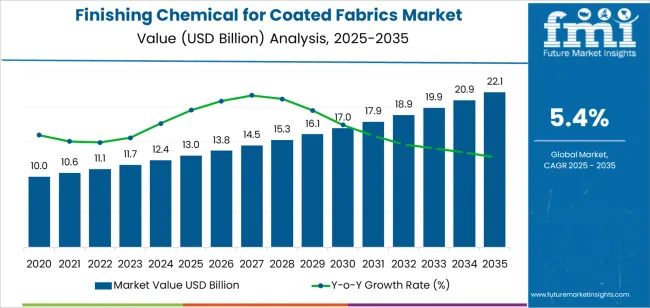
| Metric | Value |
|---|---|
| Finishing Chemical for Coated Fabrics Market Estimated Value in (2025 E) | USD 13.0 billion |
| Finishing Chemical for Coated Fabrics Market Forecast Value in (2035 F) | USD 22.1 billion |
| Forecast CAGR (2025 to 2035) | 5.4% |
The market is segmented by Finishing Chemical Type, Fabric Type, and End Use and region. By Finishing Chemical Type, the market is divided into Silicone Softeners, Cationic Softeners, Antistatic Agent, Durable Water Repellents (DWR), Flame Retardants, Anti-pilling Cum Antislip Agent, Anticrease Resins, Wicking Agent, Yarn Lubricants, Stiffeners, Polyurethane Finishing Agent, Wax Finishing Agent, Enzymatic Bio-polishing Agent, and Other Finishing Auxiliaries. In terms of Fabric Type, the market is classified into Synthetic and Natural. Based on End Use, the market is segmented into Automotive Interiors, Apparel, Medical Textile, Military & Defence Textile, Sports Textile, Home Furnishings, and Others. Regionally, the market is classified into North America, Latin America, Western Europe, Eastern Europe, Balkan & Baltic Countries, Russia & Belarus, Central Asia, East Asia, South Asia & Pacific, and the Middle East & Africa.
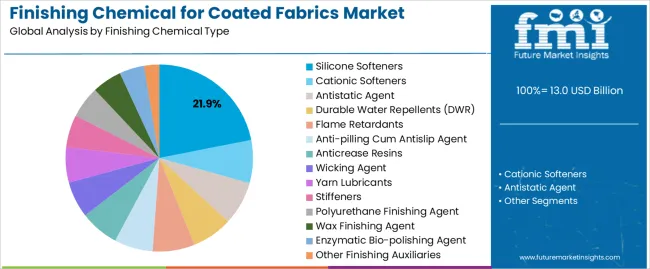
The Silicone Softeners segment is projected to account for 21.90% of the finishing chemical for coated fabrics market revenue in 2025, maintaining its competitive edge due to superior tactile enhancement and thermal stability. This segment’s growth has been driven by the ability of silicone-based agents to provide exceptional softness, lubricity, and surface smoothness without compromising fabric strength.
Industrial usage reports and technical datasheets have emphasized the importance of silicone softeners in enhancing fabric hand-feel and extending the functional lifespan of coated textiles, particularly those exposed to high temperatures or abrasion.
Furthermore, their hydrophobic properties and compatibility with a wide range of synthetic substrates have made them a preferred choice in automotive and outdoor applications. With an increasing focus on premium finishes and durability in coated fabric production, silicone softeners are expected to retain their market relevance and continue as the most widely adopted softening agent across key performance-driven sectors.
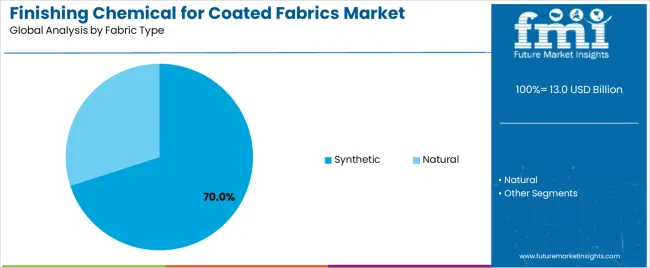
The Synthetic segment is projected to contribute 70.0% of the finishing chemical for coated fabrics market revenue in 2025, establishing it as the dominant fabric type. This growth has been driven by the widespread use of synthetic fibers such as polyester, nylon, and polyurethane in coated fabric production due to their cost efficiency, structural integrity, and adaptability to functional enhancements.
Technical evaluations have shown that synthetic fabrics are more receptive to various finishing chemicals, enabling properties like flame resistance, water repellency, and UV protection to be effectively integrated.
Additionally, synthetic substrates are preferred in automotive, industrial, and outdoor applications due to their resistance to wear, tear, and environmental conditions. Manufacturers have scaled production of coated synthetic fabrics to meet sectoral demand for high-performance, lightweight, and customizable materials. The segment’s leadership is expected to persist, supported by ongoing innovation in fabric engineering and the continued shift from natural to synthetic fiber usage in coated applications.
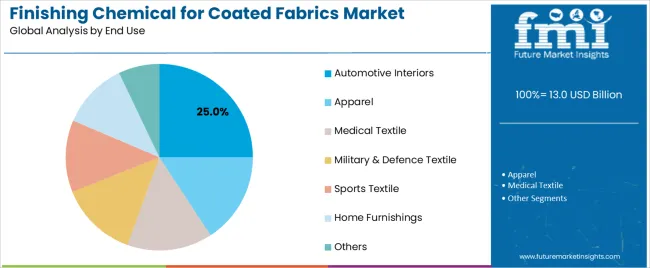
The Automotive Interiors segment is projected to represent 25.0% of the finishing chemical for coated fabrics market revenue in 2025, making it the leading end-use category. Growth of this segment has been shaped by the rising integration of coated fabrics in vehicle interiors to enhance aesthetics, comfort, and functionality.
Automotive OEMs have increasingly opted for coated textiles that are resistant to UV exposure, staining, and abrasion, requiring advanced finishing chemical treatments to meet stringent performance standards.
Industry publications and supplier updates have reported consistent demand for soft-touch finishes, enhanced durability, and improved fire-retardant properties in automotive seating, door panels, and dashboards. Additionally, consumer demand for premium vehicle interiors has driven manufacturers to utilize innovative surface treatments, including silicone-based and low-emission finishing agents. With electric vehicle interiors emphasizing lightweight and sustainable materials, the need for high-quality coated fabrics is projected to rise further. The Automotive Interiors segment is expected to maintain its leading position, backed by continuous advancements in materials technology and the evolution of automotive design priorities.
The table below presents the expected CAGR for the global finishing chemical for coated fabric market over several semi-annual periods spanning from 2025 to 2035. In the first half (H1) of the decade from 2025 to 2035, the sector is predicted to surge at a CAGR of 5%, followed by a slightly higher growth rate of 5.2% in the second half (H2) of the same decade.
| Particular | Value CAGR |
|---|---|
| H1 | 5% (2025 to 2035) |
| H2 | 5.2% (2025 to 2035) |
| H1 | 4.9% (2025 to 2035) |
| H2 | 5.2% (2025 to 2035) |
Moving into the subsequent period, from H1 2025 to H2 2035, the CAGR is projected to decline slightly to 4.9% in the first half and remain relatively considerable at 5.2% in the second half. In the first half (H1), the sector witnessed a decrease of 20 BPS, while in the second half (H2), the growth rate surged by 10 BPS.
Increasing Awareness of Bio-based Agents to Spur Sales
The textile finishing chemical market size is predicted to showcase a 3.1% increase in CAGR through 2035 compared to the historical one. This is due to the growing demand for silicone softeners, antistatic agents, and flame retardants across a wide range of industries, including apparel and automotive interiors. Global sales of finishing chemicals for coated fabrics are set to rise due to growing awareness of new types of chemicals like bio-based agents.
Need to Prevent Electrostatic Discharge Augments Demand Worldwide
The prevention of electrostatic discharge (ESD) is an important factor boosting demand for anti-static chemicals in the coated fabric sector. ESD causes damage to personnel, devices, and components across key industries like healthcare, automotive, and electronics.
Coated fabrics treated with anti-static finishes are hence set to be used in medical garments, bedding fabric, and equipment covers. The main focus is on minimizing the risk of shock and ensuring a safe and reliable healthcare environment.
In the automotive industry, anti-static properties are important for materials used in interior and exterior components. Static electricity attracts dust and dirt, which leads to contamination. The buildup of static charge can also cause problems with fuel systems in the automobile.
The use of anti-static finishing agents is projected to help ensure the mitigation of these risks and increase the durability of automotive components. As industries increasingly prioritize the protection of sensitive components and the safety of workers, demand for anti-static chemicals in coated fabrics is rising.
Implementation of Stringent Fire Safety Norms Fuels Growth
Increasing concerns over fire safety and strict regulations set by regulatory bodies are pushing demand for flame retardant chemicals. Regulatory bodies like the National Fire Protection Association in the United States have established detailed guidelines and standards for fire safety.
In the automotive industry, flame retardant-coated fabrics are essential for making vehicle interiors. Hence, these materials must meet strict fire standards to ensure passenger safety in the event of fires. Implementation of fire safety regulations is set to augment demand for flame retardant chemicals.
Public transportation networks like buses, trains, and airplanes also require flame-retardant fabrics. These specialized fabrics are projected to be used in upholstery, curtains, and other interior elements, ensuring maximum passenger safety in case of a fire emergency. Finishing chemicals for coated fabrics market analysis shows that growing emphasis on fire safety across industries is set to propel demand for flame retardant chemicals.
Environmental Impact of Conventional Chemicals to Hamper Demand
Finishing chemicals are mainly derived from petrochemicals, which contribute to multiple forms of pollution and environmental degradation. The environmental impact of these chemicals acts as a leading constraint in the growth of the sector.
During the manufacturing process, large volumes of wastewater containing harmful chemicals are discharged into rivers, lakes, and other water bodies. This wastewater carries toxic substances like heavy metals and organic pollutants, which are harmful and life-threatening to aquatic life, thereby creating an imbalance in the aquatic ecosystem.
The contamination of water resources further affects biodiversity and poses health risks to communities that rely on these water sources for drinking and agriculture. The production of these chemicals is associated with the release of volatile organic compounds (VOCs) into the atmosphere.
These emissions contribute to smog formation, acid rain, and respiratory problems. Key players in the finishing chemical for coated fabric industry are anticipated to face challenges due to the significant environmental impact of conventional chemicals.
Global finishing chemical sales for coated fabrics grew at a CAGR of 2.3% between 2020 and 2025. Total revenue reached about USD 11,833.4 million in 2025. In the forecast period, the global industry is set to thrive at a CAGR of 5.4%.
The sector witnessed steady growth between 2020 and 2025. This was due to increased demand for finishing chemicals from the textile industry and a high focus on improving product quality.
The COVID-19 pandemic also underscored the crucial usage of chemicals for coated fabrics in various applications. Companies became aware of the importance of these chemicals, which increased demand in the historical period.
The finishing chemical for coated fabric market forecast shows a value of USD 20,992.2 million by 2035. This is due to a combination of several factors, including increasing demand for coated specialized fabrics, technological advancements in production processes, and robust expansion of end-use industries.
Wax finishing agents are projected to witness considerable demand in the industry through 2035 amid ability to enhance durability of the fabric by creating a protective barrier. These agents are set to be applied to fabrics needed to make tents, jackets, and outdoor furniture to provide resistance against moisture, wind, and abrasion.
Tier 1 companies comprise industry leaders with a revenue of above USD 100 million, capturing a significant share of 15% to 20% globally. A broad range of products and a large production capacity define these leaders. Tier 1 enterprises are characterized by a wide geographic reach supported by a strong customer base and a great deal of experience in producing chemicals for multiple industries.
These offer a large selection of goods. These businesses also make investments in cutting-edge manufacturing technologies to meet regulatory requirements and provide high-quality products. Prominent companies within Tier 1 include The Dow Chemical Company, Nisshinbo Textile Inc., Schüler and Co. K.G, and Piedmont Chemical Industries.
Tier 2 companies include mid-size players with revenue of USD 50 to 100 million, having a presence in specific regions and highly influencing the local market. These are distinguished by having a significant international presence and in-depth industry expertise.
These industry leaders guarantee regulatory compliance and use cutting-edge technologies. These might not, however, have cutting-edge technology or a broad worldwide reach. Prominent companies in Tier 2 include Colourinn, Embassy Silicones, Kowa Emori Co Ltd., William Clark, and Pincroft.
Tier 3 includes most of the small-scale companies operating locally and serving niche markets with revenue below USD 50 million. These businesses are categorized as Tier 3 share because these are particularly focused on meeting local demands.
These are regionally focused and small-scale players. When compared to structured competition, Tier 3 is considered an unorganized market because it is a sector lacking in comprehensive structure and formalization. Prominent companies in Tier 3 include Schill+Seilacher, Weidmann GmbH, Protex Korea, ICEI, PT Hybrid Chemicals, Versachem, Chemdyes SDN Bhd, Chemstar, and Best Chemical Industry.
The table below highlights the estimated growth rates of the leading countries. China, ASEAN, and India are set to record high CAGRs of 7.2%, 7%, and 6.7%, respectively, through 2035.
| Countries | CAGR 2025 to 2035 |
|---|---|
| China | 7.2% |
| ASEAN | 7% |
| India | 6.7% |
| South Korea | 6.3% |
| Türkiye | 6.1% |
Growth factors influencing the finishing chemical for coated fabrics market in China include high demand from the automotive and apparel sectors. The country is projected to reach USD 3,917 million by 2035. Over the evaluation period, demand is set to rise at 7.2% CAGR.
China’s textile industry is diversified, including a range of applications like apparel, automotive interior, and industrial fabrics. Demand for these chemicals is driven by the need to enhance the durability, performance, and appeal of coated fabrics.
As China’s automotive sector continues to flourish, there is an increasing demand for highly specialized fabrics which have specific characerictics. These can be used in the interior of vehicles. Coated fabrics treated with flame retardants, anti-static agents, and UV-resistant finishes are essential to meet the safety and comfort standards expected by today’s customers.
China houses a well-established manufacturing hub, thereby influencing sales. The country’s vast capabilities in manufacturing allow for the large-scale production of finishing chemicals and coated fabrics. This helps support competitive pricing and innovation in the development of new chemical processes and formulations.
China’s push towards modernization and technological advancement has increased innovation in the textile chemical sector. The integration of smart textiles and advanced materials into consumer products is further driving demand for these chemicals.
India is set to demonstrate a considerable growth rate in the sector. Favorable government initiatives and increasing purchasing power of most of the population are projected to boost growth.
India’s customers are seeking fabric options that have high functionality apart from the basic features. Consumers are becoming aware of the benefits of anti-crease, flame retardancy, and water resistance characteristics. This shift in preference necessitates the use of specialized finishing chemicals to meet the evolving requirements.
Sales of finishing chemicals in India are projected to soar at a CAGR of around 6.7% during the forecast period. Total value is anticipated to reach USD 2,470.2 million by 2035.
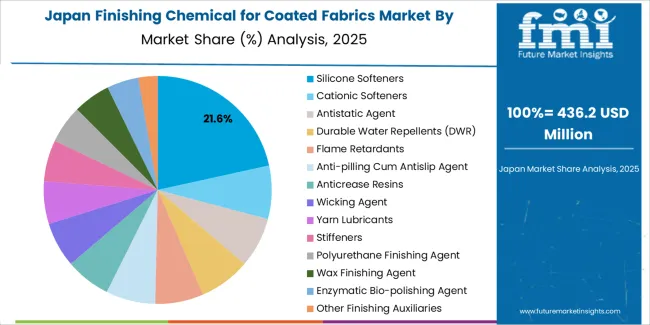
Japan is known for advanced manufacturing capabilities, strict quality regulations, and innovation-based approach. The country’s commitment to environmental sustainability and regulatory compliance provides a good opportunity for manufacturers.
Emerging companies are projected to offer eco-friendly and bio-based finishing chemicals. Strict environmental regulations and high consumer preference for sustainable products are anticipated to push the need for bio-based finishing chemicals. This is one of the key market trends in finishing chemicals for coated fabric.
Japan's advanced research and development capabilities also play a key role in creating opportunities for companies. Collaborative efforts between manufacturers, academic institutions, and research organizations will likely lead to innovations in chemical formulations and application techniques.
Japan’s value is anticipated to total USD 1,865.6 million by 2035. Over the forecast period, demand in the country is set to increase at a steady CAGR of 6.6%.
The section below shows the silicone softeners segment dominating based on finishing chemical type. The segment is forecast to thrive at 4% CAGR between 2025 and 2035. Based on fabric type, the synthetic segment is anticipated to exhibit a CAGR of 5.6% during the forecast period. Based on end-use, the apparel segment is set to witness a CAGR of 4.6% during the estimated period.
| Segment | Silicone Softeners (Finishing Chemical Type) |
|---|---|
| Value CAGR (2025 to 2035) | 4% |
Based on finishing chemical type, the silicone softeners segment is projected to witness high demand through 2035. These softeners provide exceptional softness and smoothness to fabrics, enhancing the properties and making the textile feel luxirous. These are also highly durable and can withstand multiple washes while maintaining the softening effect, thereby boosting sales.
Cationic softeners, on the other hand, have a strong affinity to negatively charged fibers like cotton and wool. These softeners provide a soft and silky feel to the fabric. Such softeners also possess excellent antistatic properties, making these suitable for synthetic fibers prone to static build-up.
Over the forecast period, demand for silicone softeners is forecast to rise at a CAGR of 4%. By 2025, the target segment is estimated to reach USD 3,578.9 million.
| Segment | Apparel (End-use) |
|---|---|
| Value CAGR (2025 to 2035) | 4.6% |
Based on end-use, the apparel category will likely remain at the forefront by showcasing a 4.6% CAGR through 2035. The segment is set to attain a value of USD 6,349.5 million by 2035.
The apparel sector is set to extensively utilize finishing chemicals in coated fabrics to meet the diverse and evolving demands of consumers. Water-repellent finishes are essential for outdoor and sportswear, ensuring that garments remain dry and comfortable in wet conditions. Stain-resistant coatings are projected to help maintain the appearance of clothing by preventing dirt and spills from penetrating the fabric.
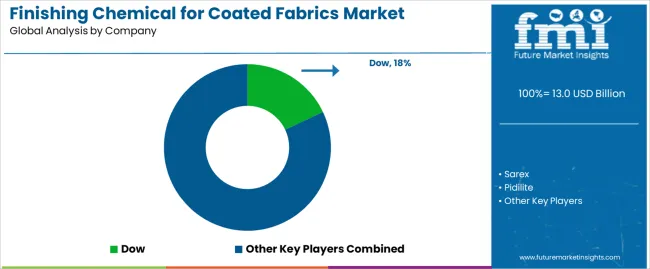
The competitive landscape of the finishing chemical for coated fabrics industry is consolidated, with leading players accounting for about significant share. The Dow Chemical Company, Nisshinbo Textile Inc, Schüler and Co. K.G, Piedmont Chemical Industries, Momentive Performance Materials, Pidilite Industries Limited, Rudolf Group, FCL Fineotex, and Sarex are the leading manufacturers and suppliers of finishing chemicals for coated fabrics listed in the report.
Key finishing chemicals for coated fabric manufacturers are focusing on launching cutting-edge products to cater to the specific needs of several industries. A few leading players aim to set up innovative production facilities in emerging countries to tap into niche areas and surge sales. With a growing focus on reducing carbon footprint, companies are coming up with sustainable products to create an eco-friendly business environment.
Industry Updates
The industry is divided into silicone softeners, cationic softeners, antistatic agents, durable water repellents (DWR), flame retardants, anti-pilling cum antislip agents, anticrease resins, wicking agents, yarn lubricants, stiffeners, polyurethane finishing agent, wax finishing agent, enzymatic bio-polishing agent, and other finishing auxiliaries.
In terms of fabric type, the sector is bifurcated into natural and synthetic. The natural segment is trifurcated into cotton, silk, and others. The synthetic segment is divided into polyamide (nylon), polyester, and others.
A few end-uses include apparel, automotive interiors, medical textiles, military and defense textiles, sports textiles, and home furnishings.
Information about key countries of North America, Latin America, Western Europe, Eastern Europe, East Asia, South Asia and Pacific, and the Middle East and Africa is given.
The global finishing chemical for coated fabrics market is estimated to be valued at USD 13.0 billion in 2025.
The market size for the finishing chemical for coated fabrics market is projected to reach USD 22.1 billion by 2035.
The finishing chemical for coated fabrics market is expected to grow at a 5.4% CAGR between 2025 and 2035.
The key product types in finishing chemical for coated fabrics market are silicone softeners, cationic softeners, antistatic agent, durable water repellents (dwr), flame retardants, anti-pilling cum antislip agent, anticrease resins, wicking agent, yarn lubricants, stiffeners, polyurethane finishing agent, wax finishing agent, enzymatic bio-polishing agent and other finishing auxiliaries.
In terms of fabric type, synthetic segment to command 70.0% share in the finishing chemical for coated fabrics market in 2025.






Full Research Suite comprises of:
Market outlook & trends analysis
Interviews & case studies
Strategic recommendations
Vendor profiles & capabilities analysis
5-year forecasts
8 regions and 60+ country-level data splits
Market segment data splits
12 months of continuous data updates
DELIVERED AS:
PDF EXCEL ONLINE
Hair Finishing Stick Market Size and Share Forecast Outlook 2025 to 2035
Mass Finishing Consumables Market Size and Share Forecast Outlook 2025 to 2035
Functional Textile Finishing Agents Market Size and Share Forecast Outlook 2025 to 2035
Chemical Vapor Deposition Market Forecast Outlook 2025 to 2035
Chemical Recycling Service Market Forecast Outlook 2025 to 2035
Chemical Dosing Equipment Market Size and Share Forecast Outlook 2025 to 2035
Chemical Filling System Market Size and Share Forecast Outlook 2025 to 2035
Chemical Absorbent Pads Market Size and Share Forecast Outlook 2025 to 2035
Chemical Indicator Inks Market Size and Share Forecast Outlook 2025 to 2035
Chemical Boiler Market Size and Share Forecast Outlook 2025 to 2035
Chemical Hardener Compounds Market Size and Share Forecast Outlook 2025 to 2035
Chemical Anchors Market Size and Share Forecast Outlook 2025 to 2035
Chemical Peel Market Size and Share Forecast Outlook 2025 to 2035
Chemical Protective Gloves Market Size and Share Forecast Outlook 2025 to 2035
Chemical Injection Pump Market Size and Share Forecast Outlook 2025 to 2035
Chemical Liquid Hydrogen Market Size and Share Forecast Outlook 2025 to 2035
Chemical Sensors Market Size and Share Forecast Outlook 2025 to 2035
Chemical Resistant EVA Film Market Size and Share Forecast Outlook 2025 to 2035
Chemical Resistant Coating Market Size and Share Forecast Outlook 2025 to 2035
Chemical Distribution Market Size and Share Forecast Outlook 2025 to 2035

Thank you!
You will receive an email from our Business Development Manager. Please be sure to check your SPAM/JUNK folder too.
Chat With
MaRIA